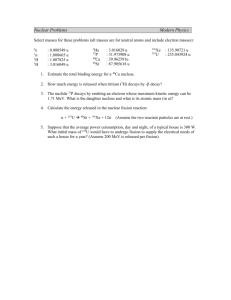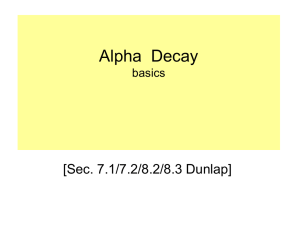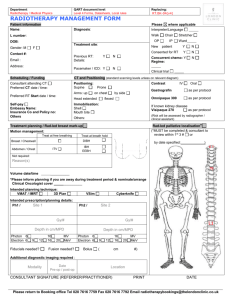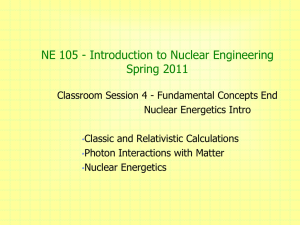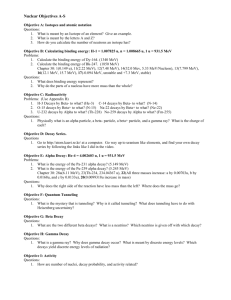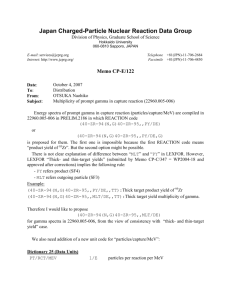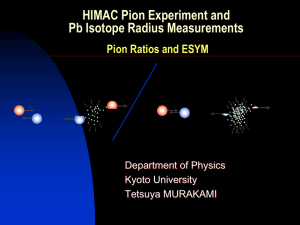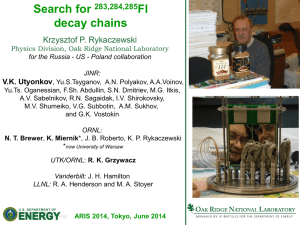these - Helios
advertisement
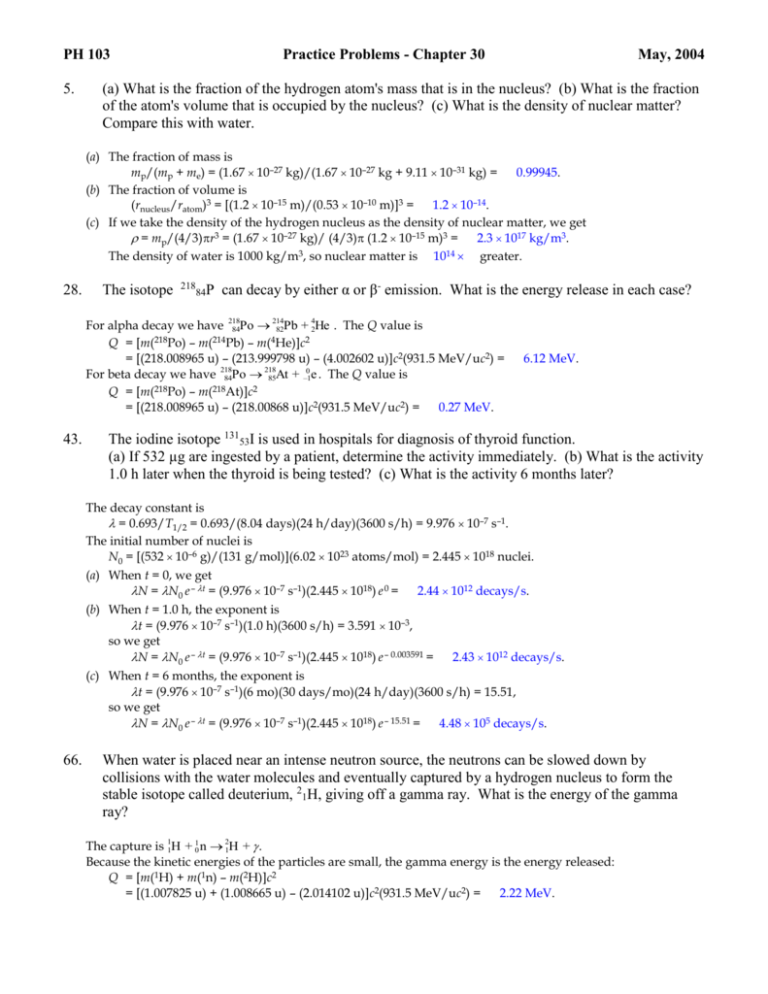
PH 103 5. Practice Problems - Chapter 30 May, 2004 (a) What is the fraction of the hydrogen atom's mass that is in the nucleus? (b) What is the fraction of the atom's volume that is occupied by the nucleus? (c) What is the density of nuclear matter? Compare this with water. (a) The fraction of mass is mp/(mp + me) = (1.6710–27 kg)/(1.6710–27 kg + 9.1110–31 kg) = 0.99945. (b) The fraction of volume is (rnucleus/ratom)3 = [(1.210–15 m)/(0.5310–10 m)]3 = 1.210–14. (c) If we take the density of the hydrogen nucleus as the density of nuclear matter, we get = mp/(4/3)r3 = (1.6710–27 kg)/ (4/3) (1.210–15 m)3 = 2.31017 kg/m3. The density of water is 1000 kg/m3, so nuclear matter is 1014 greater. 28. The isotope 218 84P can decay by either α or β- emission. What is the energy release in each case? 82Pb + 2He . The Q value is For alpha decay we have 84Po 218 214 Q = [m( Po) – m( Pb) – m(4He)]c2 = [(218.008965 u) – (213.999798 u) – (4.002602 u)]c2(931.5 MeV/uc2) = 218 0 For beta decay we have 218 85At + –1e . The Q value is 84Po Q = [m(218Po) – m(218At)]c2 = [(218.008965 u) – (218.00868 u)]c2(931.5 MeV/uc2) = 0.27 MeV. 218 43. 214 4 6.12 MeV. The iodine isotope 13153I is used in hospitals for diagnosis of thyroid function. (a) If 532 µg are ingested by a patient, determine the activity immediately. (b) What is the activity 1.0 h later when the thyroid is being tested? (c) What is the activity 6 months later? The decay constant is = 0.693/T1/2 = 0.693/(8.04 days)(24 h/day)(3600 s/h) = 9.976 10–7 s–1. The initial number of nuclei is N0 = [(53210–6 g)/(131 g/mol)](6.021023 atoms/mol) = 2.4451018 nuclei. (a) When t = 0, we get N = N0 e – t = (9.97610–7 s–1)(2.4451018) e 0 = 2.441012 decays/s. (b) When t = 1.0 h, the exponent is t = (9.97610–7 s–1)(1.0 h)(3600 s/h) = 3.59110–3, so we get N = N0 e – t = (9.97610–7 s–1)(2.4451018) e – 0.003591 = 2.431012 decays/s. (c) When t = 6 months, the exponent is t = (9.97610–7 s–1)(6 mo)(30 days/mo)(24 h/day)(3600 s/h) = 15.51, so we get N = N0 e – t = (9.97610–7 s–1)(2.4451018) e – 15.51 = 4.48105 decays/s. 66. When water is placed near an intense neutron source, the neutrons can be slowed down by collisions with the water molecules and eventually captured by a hydrogen nucleus to form the stable isotope called deuterium, 21H, giving off a gamma ray. What is the energy of the gamma ray? The capture is 1H + 10 n 1H + . Because the kinetic energies of the particles are small, the gamma energy is the energy released: Q = [m(1H) + m(1n) – m(2H)]c2 = [(1.007825 u) + (1.008665 u) – (2.014102 u)]c2(931.5 MeV/uc2) = 2.22 MeV. 1 2 PH 103 10. Practice Problems - Chapter 31 Calculate the Q-value for the “capture” reaction 16 8O (α, γ) 2010Ne. For the reaction 168O (, )20 10Ne , we determine the Q-value: Q = [m(16O) + m(4He) – m(20Ne)]c2 = [(15.994915 u) + (4.002602 u) – (19.992435 u)]c2(931.5 MeV/uc2) = 24. May, 2004 + 4.734 MeV. What is the average kinetic energy of protons at the center of a star where the temperature is 107 K? We find the average kinetic energy from KE = (3/2) kT = (3/2) (1.3810–23 J/K)(107 K )/(1.6010–19 J/eV) = 1.29103 eV = 40. 1.3 keV. A 0.018-Ci sample of 3215P is injected into an animal for tracer studies. If a Geiger counter intercepts 20% of the emitted β particles, what will be the counting rate, assumed 90%? If the counter counts 90% of the intercepted particles, we have n = (0.90)(0.20)(0.01810–6 Ci)(3.71010 decays/s · Ci) = 120 counts/s. 45. Huge amounts of radioactive 13153I were released in the accident at Chernobyl in 1986. Chemically, iodine goes to the human thyroid. (Doctors can use it for diagnosis and treatment of thyroid problems.) In a normal thyroid, 13153I absorption can cause damage to the thyroid. (a) Write down the decay scheme for 13153I (see page 1066 for the decay mode). (b) Its half-life is 8.04 d; how long would it take for ingested 13153I to become 10% of the initial value? (c) Absorbing 1 mCi of 13153I can be harmful; what mass of iodine is this? (a) 53I 54Xe + – 01e + + . (b) We find the number of half-lives from N/N0 = (½)n; (0.10) = (½)n, or n log 2 = log 10, which gives n = 3.32. Thus the elapsed time is ∆t = nT1/2 = (3.32)(8.0 days) = 27 days. (c) We find the number of atoms from Activity = N; (1.0010–3 Ci)(3.71010 decays/s · Ci) = [0.693/(8.0 days)(86,400 s/day)]N, which gives N = 3.691013 atoms. The mass is m = [(3.691013 atoms)/(6.021023 atoms/mol)](131 g/mol) = 8.010–9 g. 131 131 PH 103 4. Practice Problems - Chapter 32 May, 2004 What is the time for one complete revolution for a very high-energy proton in the 1.0 km radius Fermilab accelerator? Very high-energy protons will have a speed v c. Thus the time for one revolution is t = 2πr/v = 2π(1.0103 m)/(3.00108 m/s) = 2.110–5 s = 21 µs. 19. How much energy is released in the decay + µ+ + µ? For the reaction π+ µ+ + µ , we determine the Q-value: Q = [m(π+) – m(µ+)]c2 = [(139.6 MeV/c2) – (105.7 MeV/c2)]c2 = 33.9 MeV. Thus 33.9 MeV is released. 25. What are the wavelengths of the two photons produced when a proton and antiproton at rest annihilate? The energy of the two photons must be the rest mass energy of the proton and antiproton: 2m0c2 = 2hf = 2hc/; 2(938.3 MeV/c2)c2 = 2(1.2410–12 MeV · m)/, which gives = 39. 1.3210–15 m. What particles do the following quark combinations produce? Note: underline means the antiparticle. Refer to Table 32-2 and Table 32-4. (a) u u d, (b) u u s, (c) u s, (d) d u, (e) c s. (a) For u u d we have charge +1, baryon number = + 1, while strangeness, charm, bottomness, and topness = 0. Thus we have p. (b) For u us = u u s we have charge = – 1, baryon number = – 1, strangeness = + 1, while charm, bottomness, and topness = 0. Thus we have + . (c) For u s we have charge = – 1, baryon number = 0, strangeness = – 1, while charm, bottomness, and topness = 0. Thus we have K–. (d) For d u we have charge = – 1, baryon number = 0, strangeness = 0, while charm, bottomness, and topness = 0. Thus we have π–. (e) For cs we have charge = – 1, baryon number = 0, strangeness = – 1, charm = – 1, while bottomness, and topness = 0. Thus we have D –S .


